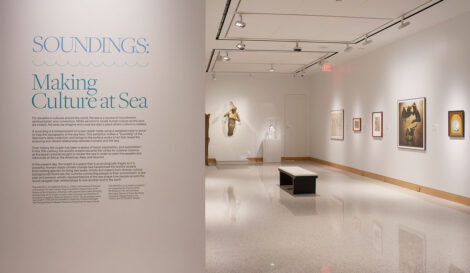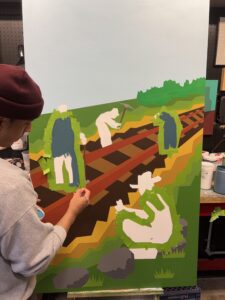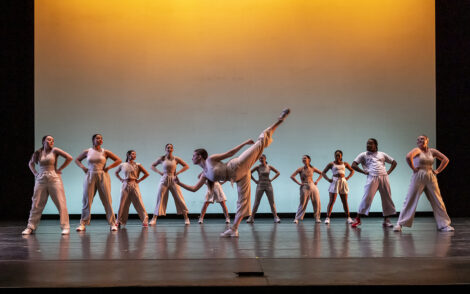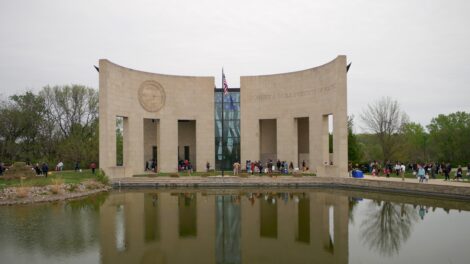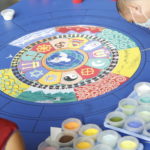Museum tangled in history of hair
INDEPENDENCE, MO. ? Leila Cohoon is standing in the middle of a room, miles of human hair surrounding her.
The hair, mostly shades of brown and black, is coiled into recognizable forms – a wreath, a flower, a heart, a cross, a bald eagle, a butterfly. The designs are displayed in shadow boxes lined up on white walls.
Cohoon’s own hair is bright blond. It’s fixed to look like it belongs atop a woman who’s been a hairdresser for 57 years.
She’s spouting facts about hair. She sounds less like a professor and more like a kid who’s got a secret to tell.
A mummy dug up by scientists in Egypt still had its original hairstyle – right down to the curl. It’s true. She saw it on a National Geographic TV special.
Civil War soldiers often wore watch fobs made out of the hair of their wives, to have a piece of home with them on the battlefield.
Mounds of human hair are still sitting near the ovens at the Auschwitz concentration camp in Germany. The hair hasn’t been touched since it was shaved off of the Jews being murdered.
She could go on all day.
“Hair is an obsession,” she admits.
Since 1990, she’s operated Leila’s Hair Museum, which she claims is the only museum in the world devoted to hair. It shares building space with the Independence School of Cosmetology, which Cohoon founded in 1960.
Don’t expect to see antique curling irons or exotic bobby pins. This museum is dedicated almost entirely to jewelry and works of art made of human hair, an art form that has nearly gone extinct.
Family history
The museum, contained in two rooms, includes rings, bracelets, necklaces and other jewelry made from hair.
But the centerpiece clearly is Cohoon’s collection of more than 300 hair wreaths, most of them made by wrapping hair tightly around wire and shaping the wire into designs.
Hair art was a popular art form starting in the 1400s and remained through the 1800s, both in Europe and in the United States. Where the art form originated is up for debate, Cohoon says.
Often, a family member would collect hair from several generations of relatives and weave the hair into a wreath. More often than not, the wreath included intricate hair-woven flowers and were shaped like a horseshoe – always pointed up, to keep luck in the family.
It was a way to track a family tree in the days before photographs. And unless the hair gets wet, it stays in the same condition as the day it was cut.
Wreath tales
Cohoon, a feisty 74, can tell you a story about each of the wreaths on the wall. She’s writing a book about them that she hopes to finish later this year.
One shadow box, with a small picture of a girl wearing a black dress, is lined with material usually reserved for a coffin. The wreath apparently is made with hair from the girl and the girl’s mother, who had died.
Cohoon steps around a couple of dead crickets on the floor to point at another wreath.
It is oval and surrounds a genealogical chart traced back to a Benjamin Hurd, who was born in 1818.
“I wrote to Oprah,” Cohoon says. “I’m hoping she can help me find his family.”
Cohoon, whose first name is pronounced Lee-EYE-Luh, first got hooked on hairwork in 1956. She took the $35 she’d saved up for a new pair of Easter shoes and instead spent it on a small shadow box of flowers made of hair that she found at an antique shop.
These days, antique dealers know to call Cohoon when they get a good hair wreath. She finds plenty on eBay, as well. Most run a few hundred dollars, but it’s possible to spend upward of $1,000 on a good piece, especially if it comes with information about the family history.
In a way, Cohoon wishes there weren’t so many hair wreaths available for her to purchase.
“People don’t care as much about family today, and that’s unfortunate,” she says. “As a result, they get rid of things that should matter the most to their families.”
Fans and foes
A guestbook near the museum’s entrance reveals visitors from throughout the country. Many of them are tipped off by travel guides, says Charlotte Planer, who works the front desk most days.
Planer likes to give guided tours through the collection. Otherwise, the hairwork might be misunderstood, she says.
“They think they’re just looking at the hair of dead people,” she says. “They don’t realize it’s more than that.”
Joyce Cole, of Houston, is analyzing the intricate hairwork in one of the glass cases. She’s making a day trip to Independence during a weeklong vacation to Branson, Mo.
“I just thought I’d like to see this,” Cole says. “I’ve always admired hair wreaths. It’s beautiful. Just beautiful.”
Cole’s husband is waiting in the reception area. Planer says many people – especially men – don’t go into the museum with their friends or relatives.
Some simply aren’t interested. Some are grossed out.
Cohoon says she can understand if the hair elicits an emotional response from her time teaching future hairdressers.
“A student learns from the beginning, you take off a quarter-inch more than a woman wants to have off, and it’s war,” she says. “The emotion is high when you’re dealing with hair.”
Hair guru
Cohoon is credited with reviving an interest in hairwork.
With Cohoon’s help, Marlys Fladeland, of Pleasant Grove, Utah, founded the Victorian Hairwork Society. It’s dedicated to helping members collect hair art and jewelry, and teaching them how to make it.
“I get phone calls from people whose loved one passed away, or their dog died or their horse died, and they want something made,” Fladeland says. “Gosh, these people will do anything. They’ll take their dog hair and make something out of it, or their cat.”
Fladeland says anyone who brushes or combs their hair in the morning – or who dabs gel to get just the right look, or who lovingly strokes their spouse’s hair – can appreciate the hairwork’s sentimental nature.
But, Fladeland says, it’s clear Cohoon’s passion goes beyond that.
“Leila has promoted the hairwork for 30 to 40 years,” Fladeland says. “She’s kind of a guru. Anyone who spends that much money on hair art and opens a hair museum must be in love with the art.”


